13: Noise and Visual Quality
13. Noise and Visual Quality
Melvin J. Baughman, Extension Forester, Retired, University of Minnesota
Reviewed and revised in 2019 by Matthew Russell
Landowners and neighbors as well as visitors spending recreation time near forested areas all appreciate the visual quality of forests and the silence and solitude they offer. Some viewers may not recognize the biological or economic factors that influence your decisions to harvest or regenerate trees, but they will judge your land stewardship by the physical appearance of your woodland and sounds coming from it. The future of some management practices may be influenced, possibly even regulated, as a consequence of public pressure to maintain attractive woodlands. Many management practices affect the appearance of a woodland. Whether the resulting appearance is pleasing or not depends on the observer.

Visual quality and noise are of high public concern where woodlands are noticeable from adjoining land, and from nearby public roads, trails and waterways that receive heavy public use. Concern for visual quality and noise diminishes as public use declines on such sites and where your forestry activities are less noticeable.
This chapter contains management practices that will affect the public perception of your woodland. Choose those that fit your management goals and are likely to satisfy public opinion. As a general guideline, where the public is likely to see your activities, mimic nature with natural appearing stands of mixed species and sizes at random spacings. Avoid straight lines of trees or straight edges on tree stands. Keep noise to a minimum.
Noise Management
Noise from chainsaws and heavy equipment disrupts the peacefulness of a woodland and may irritate neighbors or the passing public. When operating noisy equipment within hearing distance of neighbors and public areas, reduce noise in early morning, late evening, and other inappropriate times whenever possible. Use noisy equipment during days of the week or periods of the year when the public is less likely to be close by. A 100-foot wide dense band of trees and shrubs is a reasonably effective sound barrier for ordinary vehicle noise, but may not be adequate for heavy equipment noise.
Landscape Management
Portions of your woodland that are visible from public roads, trails or waterways require special attention. Try to maintain a natural landscape in those areas. Begin by considering the part that your land plays in the overall landscape of the area.
Where there are large expanses of unbroken forest, trees may become monotonous to travelers. You can provide a visual break and a more interesting landscape along public travelways by creating a mixture of stands with different tree sizes and species. Permanent openings create more diverse habitat that offers opportunities for wildlife viewing and attract a greater diversity of wildlife.
Create or enhance a scenic vista by felling trees in the foreground or by thinning the stand or pruning lower limbs to permit a view of the broader landscape beyond. On a smaller scale you can clear sight lines through heavy undergrowth to draw attention to picturesque trees, rock formations, streams, lakes, and other scenic attractions. Local regulations may restrict land management options, such as tree cutting, near public water bodies.
Manage the tree species composition of your woodland to encourage trees with special visual appeal because of their trunk shape, blossoms, bark color, fall foliage color, or other characteristics. For example, white birch and aspen have white bark that is especially attractive when contrasted with green foliage on spruce and fir trees. In the fall, sugar maple leaves may turn brilliant red while aspen leaves turn golden. Just as gardeners plan flower gardens to bloom all summer, you can manage your woodland to create visual appeal throughout the year.
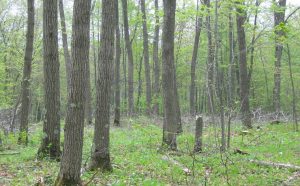
Some people prefer woodlands with a high canopy but little understory vegetation. Encourage these open, park-like conditions by maintaining a dense overstory that shades the ground and discourages understory vegetation. Dense conifer stands (such as pine, spruce, fir) block sunlight more effectively than deciduous trees. Deciduous trees such as sugar maple and oak have dense crowns that block sunlight more effectively than aspen and birch.
To block sightlines into a woodland and screen an objectionable view or create privacy, encourage shrubs and ground vegetation by lightly thinning a dense canopy. Try leaving 60 to 80 percent crown cover. For better year-round screening, establish spruce, fir, or pine along the woodland edge.

Roads and Trails
Plan systems of recreational trails, roads, skid trails, and log landings to minimize their visual impact. Locate roads and trails to:
- Minimize the total mileage required to accomplish their purposes.
- Reduce their visibility from nearby vantage points, such as scenic overlooks, streams, and lakes.
- Minimize the need for visible structures (such as bridges, culverts, ditches).
- Minimize the number of stream crossings.
- Utilize the best soils, considering potential for compaction, displacement, and erosion.
Reduce sightlines into clearcuts or landings by using small road openings through a band of trees or by designing curves in road alignment so the road visually disappears into the opening.
Locate borrow pits, rock crushing sites, and log landings out of public view behind vegetation screens or hills.
When clearing roadways, utilize merchantable timber. Avoid large debris piles that will require many years to decay. Disperse cleared debris away from the travel right-of-way so it is less visible. Push stumps off to the side so they remain upright–a more natural appearance.
Soil disturbance is unattractive and a potential source of erosion and subsequent water pollution. Compacted areas also may not regenerate with trees or other vegetation as readily as less disturbed areas. Erosion is most likely to occur soon after construction so shape and stabilize disturbed areas (such as ditches, cut-and-fill sites) as quickly as possible. Install temporary erosion control devices, such as straw bales, mulch or woody debris, to help stabilize soils before vegetation becomes established. Avoid planting grass for soil stabilization in woodlands, if possible since seeding usually introduces nonnative species.
When the road is especially susceptible to damage (such as in spring after the ground thaws and after heavy rain), stop forestry activities and close the roads. To keep mud off public roads,
- Harvest when the ground is dry or frozen, or
- Maintain a hard surface on the haul road, or
- Provide clean fill (gravel or wood chips) on the haul road for about 200 feet before the highway entrance.
Close a road after its primary use has ceased. Remove culverts, temporary bridges, signs, or other structures no longer needed. Fill in ruts and stabilize eroding areas by re-shaping, seeding, and fertilizing as appropriate. Rehabilitate borrow pits when their use has ended. Re-shape the pit to fit natural landscape contours, spread good soil over the surface, and reseed.
Timber Harvesting
In most areas less than three percent of the whole forest is subject to harvesting in a single year, so the visual impact of timber harvesting on a large landscape is relatively minor until the effects accumulate over a long period of time. However, in the small areas where timber harvesting does occur, it can dramatically alter the appearance of a woodland. To minimize visual impacts of harvesting, plan harvest and regeneration systems that quickly regenerate trees. Each harvest and regeneration system described in Chapter 4 has a different visual effect.
Determine the preferred operating season for a specific site to help avoid unwanted impacts. Soils are most susceptible to compaction, rutting, and puddling immediately after the spring thaw and following heavy rain. On low-strength soils (such as those with high organic content), use low ground pressure equipment or drive on slash mats to avoid soil damage.
Harvest stands by the single-tree or group selection method to produce an uneven-aged woodland and avoid the temporary barren appearance of clearcuts. Keep in mind, however, that the selection method regenerates mainly shade-tolerant tree species.
The difference between group selection and clearcutting is a matter of scale. Clearcuts often are described as larger than two acres whereas group selection cuts are smaller.
Soften the visual affect of clearcuts by making them appear to be less
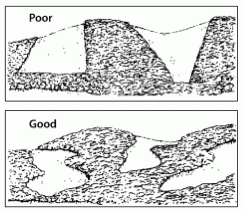
than 10 acres in size:
- Cut them in narrow, irregular shapes.
- Shape them so only a small portion is visible from a travelway.
- Leave tree islands or corridors of uncut trees across clearcuts.
- Position them to follow major land contours rather than cutting across contours (Figure 12-4).
- Leave bands of uncut trees between the clearcut and public roads, trails, or waterways.
- Feather the borders where they adjoin stands of older trees (Figure 12-5).
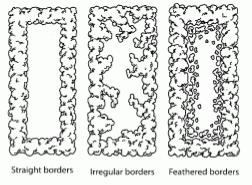
Some people prefer the appearance of complete clearcuts where no trees are left standing, whereas others prefer clearcuts that retain scattered live trees. Scattered live trees break up the monotony of large clearcuts and provide vertical habitat for birds. Some songbirds and raptors benefit from the residual trees.
Dead standing trees, called snags, may have little visual appeal, but there are many wildlife species that depend on them for nesting, denning, feeding, and roosting sites as well as escape areas. Near travelways, do not leave snags in the foreground and hide scattered snags with vegetative islands or locate snags around the edge of an opening to allow for camouflage by background trees.
During selection harvests, control the direction of fall to minimize damage to residual trees and position the fallen tree for skidding. Leave bumper trees standing along roads and skid trails to protect nearby trees of better quality that will be left standing. Fell bumper trees last.
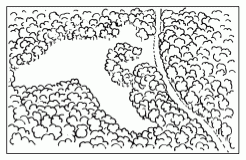
Woody debris left in a woodland after harvest can be unsightly. Remove as much wood as possible for products. Cut stumps low and lop slash so that it is no more than two to four feet above ground level. Woody debris near the ground decays more quickly because of higher humidity and is concealed more quickly by new tree growth. Near heavily traveled public roads, avoid piles of woody debris and eliminate or minimize slash within 50 feet of travelways. Slash visible beyond 50 feet should be cut to a maximum height of two feet. To reduce the amount of unusable logs, limbs, and bark at log landings, trim as much unusable wood from the trees as possible before logs are skidded to a landing. When logging has been completed, burn, bury, or disperse residual woody debris and reseed landings.
Be sure to clean up refuse and discarded equipment from the harvest area.
Regeneration
Plan timber harvests to quickly encourage natural regeneration or to prepare sites for artificial regeneration. Choose a harvest system (see Chapter 4) that is compatible with the tree species you want to regenerate (see Chapter 6). Rapidly growing young trees quickly conceal logging debris and enhance visual quality.
Site preparation may be necessary to control competing vegetation or prepare a seedbed. Controlled burning, mechanical scarification, or herbicides may be recommended. Practices that can be conducted in the spring just before green-up, in the fall just before leaves turn color, or during the dormant season are less visually obtrusive than summer treatments because they do not result in unsightly dead leaves on vegetation. Avoid or screen slash piles that are visible from public travelways. Use low-impact site preparation methods such as patch or row scarification. Where herbicides are needed, use spot or strip treatments rather than broadcast treatments.
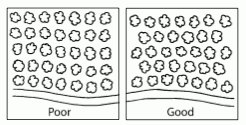
Do not plant tree rows perpendicular to travel routes. Instead, plant trees at irregular spacing or in offset rows parallel to the road to encourage natural-appearing stands. Use wider initial spacing to minimize the number of re-entries to the site for thinning and to encourage establishment of other species. Promote a mixture of species, both naturally occurring and planted. Favor long-lived species where appropriate to minimize frequency of management activities.
Woodland Improvement Practices
Thinning, culling, weed-tree removal, and pruning are common management practices aimed at changing tree species composition, improving tree quality, and increasing tree growth rates (see Chapter 5). During these activities, harvest and use as much wood as economically feasible to minimize the amount of woody debris left on the forest floor. Near travelways, keep slash height below two feet by removing, lopping, crushing or burning whenever possible. When thinning trees in rows, use selective harvesting hear travelways to break up the row affect.
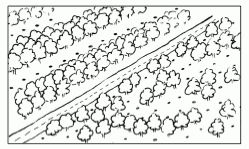
When the need arises to kill invading broadleaved hardwoods in conifer stands, favor nonherbicide treatments when possible. If herbicides are applied, leave untreated or selectively treated areas adjacent to travel routes. Favor band treatment or spot treatment over broadcast treatment. Choose late-season or dormant-season herbicides.
If you need to deaden unusable trees, kill them standing so they fall down over a period of years. In contrast, a large number of trees felled at one time will form an impenetrable mass of debris. Deaden deciduous trees during the dormant season. When such trees are killed during the growing season, they retain unsightly dead, brown leaves for several months.
Woodland Protection
As described in Chapter 7, woodlands need protection from fire, insects, and disease. Large numbers of trees damaged or killed by these agents are unsightly. Protect your woodland against these pests by following the recommendations in Chapters 6 and Chapter 7.

